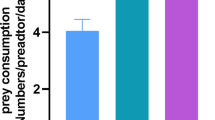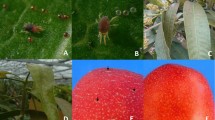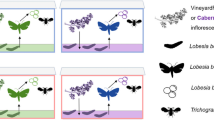Abstract
To develop a new control method for the two-spotted spider mite (TSSM), Tetranychus urticae, we investigated the effect of controlled atmospheres of carbon dioxide (CO2) on TSSM mortality under different concentrations and treatment periods, and evaluated the impact of treatments on seedlings of five host plants of TSSM. Egg hatching rate of TSSM was reduced to 37.7, 5.4 or 0% after 24 h treatment involving concentrations of 16.7, 33.3 or 50%, respectively. Mobile stages (nymphs and adult) of TSSM were completely controlled after 24 h treatment at concentrations higher than 33.3%. After 4 h at concentrations of 33.3 or 50%, 1st-day survival rate for all mobile stages was 45.3 or 36.0%, respectively, whereas after 8 or 16 h treatments, all values were decreased to zero. Seedlings of four major host plants of TSSM (cucumber, eggplant, rape, green peppers) were damaged to varying degrees after 24 h at the three concentrations, but strawberry, another host plant, was not damaged. Cucumber suffered the most serious damage, resulting in wilting and death. In conclusion, controlled atmospheres of CO2 can kill TSSM, particularly at high concentrations and with long treatment times. It can be used to control TSSM on strawberry, but should be used cautiously on other host plants.

Similar content being viewed by others
References
Abraham CM, Braman SK, Oetting RD, Hinkle NC (2013) Pesticide compatibility with natural enemies for pest management in greenhouse gerbera daisies. J Econ Entomol 106:1590–1601
Banks HJ, Annis PC (1977) Suggested procedures for controlled atmosphere storage of dry grain. Technical Paper-CSIRO Division of Entomology (Australia)
Bi JL, Niu ZM, Yu L, Toscano NC (2016) Resistance status of the carmine spider mite, Tetranychus cinnabarinus and the twospotted spider mite, Tetranychus urticae to selected acaricides on strawberries. Insect Sci 23:88–93
Carli MD, Bresolin B, Noreña CPZ, Lorini I, Brandelli A (2010) Efficacy of modified atmosphere packaging to control Sitophilus spp. in organic maize grain. Braz Arch Biol Technol 53:1469–1476
Castilho RC, Duarte VS, de Moraes GJ, Westrum K, Trandem N, Rocha LC, Delalibera I Jr, Klingen I (2015) Two-spotted spider mite and its natural enemies on strawberry grown as protected and unprotected crops in Norway and Brazil. Exp Appl Acarol 66:509–528
Costa AF, Teodoro PE, Bhering LL, Fornazier MJ, Andrade JS, Martins DS, Zanuncio JS Jr (2017) Selection of strawberry cultivars with tolerance to Tetranychus urticae (Acari: Tetranychidae) and high yield under different managements. Genet Mol Res 16:gmr16029599
Donahaye EJ (2000) Current status of non-residual control methods against stored product pests. Crop Prot 19:571–576
Fields PG, White ND (2002) Alternatives to methyl bromide treatments for stored-product and quarantine insects. Ann Rev Entomol 47:331–359
Gerson U, Weintraub PG (2012) Mites (Acari) as a factor in greenhouse management. Ann Rev Entomol 57:229–247
Gigon V, Camps C, Le Corff J (2016) Biological control of Tetranychus urticae by Phytoseiulus macropilis and Macrolophus pygmaeus in tomato greenhouses. Exp Appl Acarol 68:55–70
Gong Y, Shi B, Wang Z, Kang Z, Jin G, Cui W, Wei S (2013) Toxicity and field control efficacy of the new acaricide bifenazate to the two-spotted mite Tetranychus urticae Koch. Agrochemicals 52:225–227
Gonzalez-Dominguez SG, Santillan-Galicia MT, Gonzalez-Hernandez V, Suarez Espinosa J, Gonzalez-Hernandez H (2015) Variability in damage caused by the mite Tetranychus urticae (Trombidiformes: Tetranychidae) Koch on three varieties of strawberry. J Econ Entomol 108:1371–1380
Hashem MY, Ahmed SS, El-Mohandes MA, Gharib MA (2012) Susceptibility of different life stages of saw-toothed grain beetle Oryzaephilus surinamensis (L.) (Coleoptera: Silvanidae) to modified atmospheres enriched with carbon dioxide. J Stored Prod Res 48:46–51
Hata FT, Ventura MU, Carvalho MG, Miguel ALA, Souza MSJ, Paula MT, Zawadneak MAC (2016) Intercropping garlic plants reduces Tetranychus urticae in strawberry crop. Exp Appl Acarol 69:311–321
Held D, Potter D, Gates R, Anderson R (2001) Modified atmosphere treatments as a potential disinfestation technique for arthropod pests in greenhouses. J Econ Entomol 94:430–438
Howell AD, Daugovish O (2013) Biological control of Eotetranychus lewisi and Tetranychus urticae (Acari: Tetranychidae) on strawberry by four phytoseiids (Acari: Phytoseiidae). J Econ Entomol 106:80–85
Jeppson LR, Keifer HH, Baker EW (1975) Mites injurious to economic plants. University of California Press, London
Khajehali J, Van Nieuwenhuyse P, Demaeght P, Tirry L, Van Leeuwen T (2011) Acaricide resistance and resistance mechanisms in Tetranychus urticae populations from rose greenhouses in the Netherlands. Pest Manag Sci 67:1424–1433
Kloke JD, McKean JW (2012) Rfit: rank-based estimation for linear models. R J 4:57–64
Koveos DS, Suzuki T, Terzidou A, Kokkari A, Floros G, Damos P, Kouloussis NA (2017) Egg hatching response to a range of ultraviolet-B (UV-B) radiation doses for four predatory mites and the herbivorous spider mite Tetranychus urticae. Exp Appl Acarol 71:35–46
Kwon DH, Clark JM, Lee SH (2015) Toxicodynamic mechanisms and monitoring of acaricide resistance in the two-spotted spider mite. Pestic Biochem Physiol 121:97–101
Liu YB (2003) Effects of vacuum and controlled atmosphere treatments on insect mortality and lettuce quality. J Econ Entomol 96:1100–1107
Mitcham EJ, Zhou S, Bikoba V (1997) Controlled atmospheres for quarantine control of three pests of table grape. J Econ Entomol 90:1360–1370
Miyata K, Kikuchi T, Katoh H, Kagawa K, Sonoda S, Murai T (2016) Lethal effects of concentrated CO2 on adult females and eggs of Frankliniella occidentalis and Frankliniella intonsa (Thysanoptera: Thripidae) at a high temperature. Appl Entomol Zool 51:441–444
Nyoike TW, Liburd OE (2013) Effect of Tetranychus urticae (Acari: Tetranychidae), on marketable yields of field-grown strawberries in north-central Florida. J Econ Entomol 106:1757–1766
Oyamada K, Murai T (2013) Effect of fumigation of high concentration carbon dioxide on two spotted spider mite, Tetranychus urticae Koch (Acari: Tetranychidae) and strawberry runner plant. Jpn J Appl Entomol Zool 57:249–256
R Core Team (2017) R: a language and environment for statistical computing. R Foundation for Statistical Computing, Vienna
Rhodes EM, Liburd OE (2006) Evaluation of predatory mites and Acramite for control of twospotted spider mites in strawberries in north central Florida. J Econ Entomol 99:1291–1298
Seki M, Murai T (2011) Effect of high carbon dioxide atmospheres against the western flower thrips, Frankliniella occidentalis (Pergande) (Thysanoptera: Thripidae). Jpn J Appl Entomol Z 55:174–177
Seki M, Murai T (2012a) Insecticidal effect of high carbon dioxide atmospheres on thrips eggs oviposited in plant tissue. Appl Entomol Zool 47:433–436
Seki M, Murai T (2012b) Responses of five adult thrips species (Thysanoptera; Thripidae) to high-carbon dioxide atmospheres at different temperatures. Appl Entomol Zool 47:125–128
Shelton MD, Mendez V, Walter VR, Brandl D (1996) The effects of refrigerated, controlled-atmosphere storage during marine shipment on insect mortality and cut-flower vase life. HortTechnology 6:247–250
Sun JT, Lian C, Navajas M, Hong XY (2012) Microsatellites reveal a strong subdivision of genetic structure in Chinese populations of the mite Tetranychus urticae Koch (Acari: Tetranychidae). BMC Genet 13:8
Suzuki T, Ghazy NA, Amano H, Ohyama K (2012) A high-performance humidity control system for tiny animals: demonstration of its usefulness in testing egg hatchability of the two-spotted spider mite, Tetranychus urticae. Exp Appl Acarol 58:101–110
Tanaka M, Yase J, Aoki S, Sakurai T, Kanto T, Osakabe M (2016) Physical control of spider mites using ultraviolet-B with light reflection sheets in greenhouse strawberries. J Econ Entomol 109:1758–1765
Van Leeuwen T, Vanholme B, Van Pottelberge S, Van Nieuwenhuyse P, Nauen R, Tirry L, Denholm I (2008) Mitochondrial heteroplasmy and the evolution of insecticide resistance: non-Mendelian inheritance in action. Proc Natl Acad Sci USA 105:5980–5985
Van Leeuwen T, Vontas J, Tsagkarakou A, Dermauw W, Tirry L (2010) Acaricide resistance mechanisms in the two-spotted spider mite Tetranychus urticae and other important Acari: a review. Insect Biochem Mol Biol 40:563–572
Van Leeuwen T, Dermauw W, Grbic M, Tirry L, Feyereisen R (2013) Spider mite control and resistance management: Does a genome help? Pest Manag Sci 69:156–159
Van Nieuwenhuyse P, Van Leeuwen T, Khajehali J, Vanholme B, Tirry L (2009) Mutations in the mitochondrial cytochrome b of Tetranychus urticae Koch (Acari: Tetranychidae) confer cross-resistance between bifenazate and acequinocyl. Pest Manag Sci 65:404–412
Whiting DC, van den Heuvel J (1995) Oxygen, carbon dioxide, and temperature effects on mortality responses of diapausing Tetranychus urticae (Acari: Tetranychidae). J Econ Entomol 88:331–336
Wong-Corral FJ, Castane C, Riudavets J (2013) Lethal effects of CO2-modified atmospheres for the control of three Bruchidae species. J Stored Prod Res 55:62–67
Wu S, Xie H, Li M, Xu X, Lei Z (2016) Highly virulent Beauveria bassiana strains against the two-spotted spider mite, Tetranychus urticae, show no pathogenicity against five phytoseiid mite species. Exp Appl Acarol 70:421–435
Zhou SJ, Mitcham EJ (1998) Sequential controlled atmosphere treatments for quarantine control of Pacific spider mites (Acari: Tetranychidae). J Econ Entomol 91:1427–1432
Acknowledgements
The research was funded by the Beijing Municipal Science and Technology Project (D171100001617002), Innovative Team of Beijing Academy of Agriculture and Forestry Sciences (JNKYT201605) and Beijing Key Laboratory of Environmentally Friendly Pest Management on Northern Fruits (BZ0432).
Author information
Authors and Affiliations
Corresponding author
Rights and permissions
About this article
Cite this article
Gong, YJ., Cao, LJ., Wang, ZH. et al. Efficacy of carbon dioxide treatments for the control of the two-spotted spider mite, Tetranychus urticae, and treatment impact on plant seedlings. Exp Appl Acarol 75, 143–153 (2018). https://doi.org/10.1007/s10493-018-0251-1
Received:
Accepted:
Published:
Issue Date:
DOI: https://doi.org/10.1007/s10493-018-0251-1




